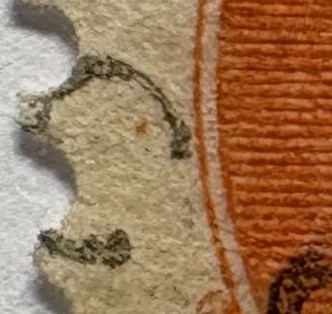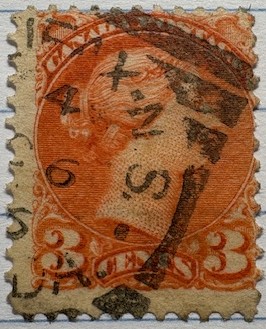| Author |
 Replies: 12 / Views: 518 Replies: 12 / Views: 518 |
|
|
Valued Member
Canada
205 Posts |
|
|
Scott catalogue states that if a Position Dot is at 3 or 9 o'clock (half way up the stamp outside medallion) then the stamp is a 37. Hillson and many others have identified that the Montreal plates were transferred to Ottawa, and continued to be used during the Second Ottawa printing period. That said, if the Montreal Plate is used in the mid to late 1890s, with bright vermillion inks, is the stamp really a 37? Opinions welcomed! Chris   |
|
Send note to Staff
|
|
|
|
|
Bedrock Of The Community
11509 Posts |
|
|
Valued Member
Canada
205 Posts |
|
|
Thank you for the image, Rogdcam. I have to disagree that the 2nd Ottawa printings 'have no PDs'. They do, I have several late 1890 PDs that show this as fact. As stated by Mr Hillson (the doyen of SQ research), the Montreal plates were used in Ottawa, thus these PDs do exist.
I am asking how other collectors feel about the Scott Catalogue assertion that any stamp with the PD 3 or 9 is a Scott 37, even if it was printed in Ottawa.
Thanks again
Chris |
Send note to Staff 
|
|
|
Bedrock Of The Community
11509 Posts |
|
|
Quote:
Position Dots
Apart from the Six Cents printed from the 'A' plate - which was still in use and is now in a shade of red brown, and which now sported anything from two to four lower left position dots - lower left position dots were all long out of service. With this one exception therefore, a stamp with a lower left dot cannot come from 2nd Ottawa. Some of the plates made in Montreal in the 1880s were still in use, so occasionally one will find dots at 3 or 9 o'clock. Generally speaking, however, 2nd Ottawa printings do not have obvious dots.
Dated Copies
From April 1894 it became officially permissible to cancel stamps with a date stamp, so the bulk of dated copies do come from 2nd Ottawa, obviously with dates after 1888!
http://www.canadianpsgb.org.uk/smal...s_print.html |
Send note to Staff 
|
|
|
Pillar Of The Community
United States
6831 Posts |
|
|
Scott gives colors and years for all six "37" entries (##37, 37a, 37b, 37c, 37d and 37e (I guess technically color, only, in the case of 37e)).
If I have a 3c SQ (design A24 in Scott-land) in bright vermilion, I'm calling it Sc#41. Dot or no dot. There isn't an option to assign it a "37" number.
And now I'm probably going to go look. (Not right now, but, you know, now-ish.) If I find a dot, I'll make a note about it.
I don't see anything dramatically different in my Unitrade.
I'll note that Robson Lowe's Encyclopedia goes into some further detail, and says that late dots could appear on the left side, or the right side (the right side being Ottawa plates dating from 1892 or later). Perhaps scholarship has added to the collective knowledge in the intervening decades?
It's mildly entertaining to trace through the history of 3c plates in RL. |
Send note to Staff 
|
|
|
Bedrock Of The Community
11509 Posts |
|
|
I guess I look at it from the perspective of what characteristic could change and/or are less subjective. Perforation rates are not going to change or be subjective nor are position dots. Colors on the other hand, especially for used stamps, are subjective and do change, especially in the orange family. All a choice of course. If the perforation rate, postmark, position dot(s) point in a certain direction but the color raises questions, what you decide is your call. |
Send note to Staff 
|
|
|
Bedrock Of The Community
11509 Posts |
|
|
Pillar Of The Community
United States
6831 Posts |
|
|
The question for this thread was: Quote:
That said, if the Montreal Plate is used in the mid to late 1890s, with bright vermillion inks, is the stamp really a 37? In answer to that question, I say, "no, that would be a better fit for 41 according to Scott." |
Send note to Staff 
|
|
|
Pillar Of The Community
574 Posts |
|
|
If I may add a comment to spice up the conversation:
Consider the possibility that the 9 o'clock dot in the margin of the OP is not a position or plate layout dot. It is more likely a random blemish on the printing plate. I will explain.
1) these W/E marginal position dots usually hug the outer oval, and are sometimes so discreet as to be undetectable.
2) typically position dots are light. The subject stamp has a dot of irregular shape, and is larger than I'd expect to see.
That being said, I'd consider it a 41 by the shade I see, and date. Of course, one cannot be certain based on a scan. |
Send note to Staff 
|
| Edited by archerg - 02/10/2025 11:45 pm |
|
|
Pillar Of The Community
United States
6831 Posts |
|
|
Interesting possibility.
Regardless, I have another reason to go through a bunch of Small Queens, looking more carefully at something I had not paid all that much attention to before. Since they're already bought and paid for, it's free entertainment. So to speak. Is this a great hobby, or what? |
Send note to Staff 
|
| Edited by Cjd - 02/11/2025 09:36 am |
|
|
Valued Member
Canada
205 Posts |
|
|
thanks to all for their comments -
I do believe that the PDs for this period are quite obvious. I have many that migrate along the midpoint of the design at both 3 and 9, on the oval line, and inside the frame. Some show guidelines. It seems too coincidental that these are all printing flaws, but appreciate the opinion.
I agree that the cumulative information denotes a Scott 41 (bright vermillion colour, Squared Circle dating).
If I was to only follow the Scott classification, to a novice this could be incorrectly identified as a 37. |
Send note to Staff 
|
|
|
Bedrock Of The Community
11509 Posts |
|
|
So in the end we are going to use color to identify a used 150+/- year old stamp. Interesting. I sense confirmation bias might be at play a wee bit. |
Send note to Staff 
|
|
|
Valued Member
Canada
205 Posts |
|
|
good point, Rogdcam. Changeling colour has always been a challenge for me. I think the Squared Circle is the best indicator of a 41 (1893 and later). The vermillion is obvious in this one. |
Send note to Staff 
|
|
| |
 Replies: 12 / Views: 518 Replies: 12 / Views: 518 |
|
